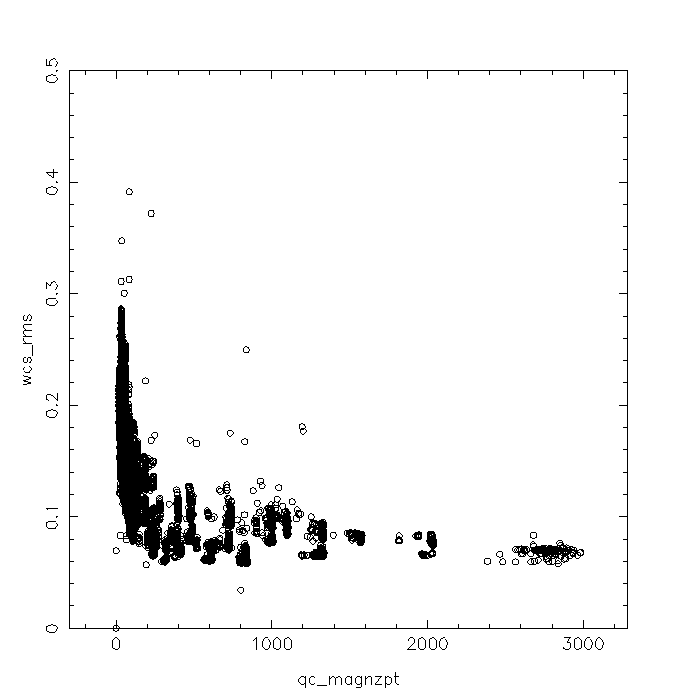 mirror sites:
PL (internal link)
HQ
[?]
mirror sites:
PL (internal link)
HQ
[?]
Quality Control and
Data Processing
|
VIRCAM: Throughput and image quaility
Since most of the VIRCAM science observations contain enough 2MASS standard stars, science images are photometrically self-calibrated by using the 2MASS catalogue. In addition to this calibration plan the observatory maintains a monitoring programme that acquires regularly photometric standard star fields. Several parameters are derived from this observations to monitor several instrument characteristics. From 2018 on it can happen that the vircam data reduction pipeline recipe for photometric standard stars cannot process chip #15. The resulting image product is coadded, but the jitter offsets are not taken into account. The failure occurs sporadically in the Z-band and since 2022 also in the Y-band. The reason is the most right channel #16 in chip #15 whith the erratic noise signal. The failure of the recipe can be fixed by modifying the bad pixel map generated by the linearity recipe, in a way that all pixel in channel #16 are flagged in addition. This modified bad pixel map must be used to process the twilight flat to generate modified master twilight flat and confidence map. Both modified twilight flat products and the modified bad pixel map must be used to process the photometric standard star field to ignored the channel #16 area during co-adding and achieve a well combined image and a final photometric zeropoint for chip #15.
An example modified bad pixel map has been ingested in the ESO master calibration archive for this purpose:
 Photometric zeropoint
Photometric zeropoint
The photometric zeropoints of H, J and K are derived from the 2MASS catalog directly. The zeropoints of Y, Z, NB119 and NB980 are derived via color equations. The trending plots show the zeropoints averaged over 16 detectors (upper left box) and the ones resolved per detector (upper right box). Zeropoints might be dependent on the choosen standard star field. For this reason the OBS.ID and the OBS.TARG.NAME is included in the database query (accesible via the [this] link). Scoring&thresholds Photometric zeropoint The values are not scored The photometric zeropoint are derived from the observation of photometric standard star fields and are dependent on several hardware and software components. While the 2MASS catalog of the same version is used through the live time of the instrument, other components changed and had an impact on the zeropoint values: A) The following hardware related interventions took place:
B) The pipeline reads the extinction coefficients and the color terms from a static calibration with PRO.CATG=PHOTCAL_TABLE. Operations started with initial values of extinction and color terms. These values were improved as more and more standard star observations became available.
The coleq_coefs column of the table should be read as : Z_VIRCAM = 2.025 * Jmag_2MASS - 1.025 * Hmag_2MASS Y_VIRCAM = 1.610 * Jmag_2MASS - 0.610 * Hmag_2MASS J_VIRCAM = 0.923 * Jmag_2MASS + 0.077 * Hmag_2MASS H_VIRCAM = 0.032 * Jmag_2MASS + 0.968 * Hmag_2MASS Ks_VIRCAM = 0.010 * Jmag_2MASS + 0.990 * Kmag_2MASS NB118_VIRCAM = 1.100 * Jmag_2MASS - 0.100 * Hmag_2MASS NB980_VIRCAM = 1.680 * Jmag_2MASS - 0.680 * Hmag_2MASSC) The following major pipeline upgrades took place.
Algorithm Photometric zeropoint The counts of identified stars are matched with the 2MASS catalog entries.  Image quality
Image quality
Independent on the used catalog, the optical system (the telescope) and the atmosphere (seeing) affect the quality of the image shape of an extraterrestrial 'point source'. In bad seeing nights, the FWHM of the point source images on the detector and the shape of the point spread function are dominated by the turbulence in the atmosphere. In good seeing nights, when the seeing is small enough, the contribution of the optical system, the image quality of the telescope and the instrument become more and more apparent. Two parameters are derived from the standard stars observations: The image size is trended here and the ellipticity is trended here. Scoring&thresholds Image quality The values are not scored High ellipticity of sources can be due to several reasons, all related to the telescope. E.g.: One or more of the M2 hexapod legs can malfunction, the instrument can continue to observe, while the telescope is already moving, the altitude or azimuth drives might vibrate.
QC.IMAGE_SIZE is the median of the FWHM of all sources  Pointing and WCS
Pointing and WCS
The VISTA telescope control software writes the coordinate system of the sky, the pointing direction, as world coordinates (ZPN projection) into the headers of the fits frames. Each raw fits frame detector extension contains the same RA and DEC (CRVAL1,2) values and the detector specific reference pixel (CRPIX1,2). The error between the real coordinates and the header coordinates, called pointing error, is monitored. Is is a property/quality of the raw frame. The pipeline, when processing the frames, applies a static optical distortion model to the VIRCAM wide field, a radial polynomial of order=3, where the zero term is a shift, the mentioned pointing error. In the absence of imperfect correction of the wide field optical distortion of VISTA, uncertainty of the barycenter of the telescope and seeing PSF, differential refraction and other effects, the minimum astrometric RMS that can be achieved is the intrinsic RMS of the 2MASS catalog. Note that 1 detector pixel corresponds to 0.339 arcsec. The residuals of thew WCS fit are monitored here and the pointing errors in RA and DEC are monitored here and here respectively. The FULL plot of the RMS of the WCS shows a linear long-term increase of the RMS. Scoring&thresholds Pointing and WCS The values are not scored No remarks.
The rms of the world coordinate system quality ocntrol parameter is derived by comparing the position of the identified photometric standard stars in the pipeline processed product frame with the positions of the same sources in the 2MASS catalog. The pipeline uses a built-in static radial polynomial to correct the large scale optical distortion of the FOV induced by the wide field imager.
The mean shift in arcsec, which was applied by the pipeline to align the raw frame header keywords on the WCS with the points sources in the pipeline product frames. This pointing error comes in two components, one as an offset value for RA (rectaszension) and as an offset value for DEC (declination). The pointing error is a quality measure of the telescope acquisition system and of the raw frame header information. The pipeline reports the pointing error in deg which is written as deg in the QC1DB. In the trending plot the values are scaled by 3600 to show them in arcsec. |
||||||||||||||||||||||||||||||||||||||||||||||||||||||||||||||||||||||||||||||||||||||||||||||||||||||||||||||||||||||||||||||||||||||||||||||||||||||||||||||||||||||||||||||||||||||||||||||||||||||||||||||||||||||||||||||||||||||||||||||||||||||||||||||||||||||||||||||||||||||||||||||||||||||||||||||||||||||||||||||||||||||||||||||||||||||||||||||||||||||||||||||||||||||||||||||||||||||||||||||||||||||||||||||||||||||||||||||||||||||||||||||||||||||||||||||||||||||||||||||||||||||||||||||||||||||||||||||||||||||||||||||
| |
|||||||||||||||||||||||||||||||||||||||||||||||||||||||||||||||||||||||||||||||||||||||||||||||||||||||||||||||||||||||||||||||||||||||||||||||||||||||||||||||||||||||||||||||||||||||||||||||||||||||||||||||||||||||||||||||||||||||||||||||||||||||||||||||||||||||||||||||||||||||||||||||||||||||||||||||||||||||||||||||||||||||||||||||||||||||||||||||||||||||||||||||||||||||||||||||||||||||||||||||||||||||||||||||||||||||||||||||||||||||||||||||||||||||||||||||||||||||||||||||||||||||||||||||||||||||||||||||||||||||||||||||
 |
|
||||||||||||||||||||||||||||||||||||||||||||||||||||||||||||||||||||||||||||||||||||||||||||||||||||||||||||||||||||||||||||||||||||||||||||||||||||||||||||||||||||||||||||||||||||||||||||||||||||||||||||||||||||||||||||||||||||||||||||||||||||||||||||||||||||||||||||||||||||||||||||||||||||||||||||||||||||||||||||||||||||||||||||||||||||||||||||||||||||||||||||||||||||||||||||||||||||||||||||||||||||||||||||||||||||||||||||||||||||||||||||||||||||||||||||||||||||||||||||||||||||||||||||||||||||||||||||||||||||||||||||||
